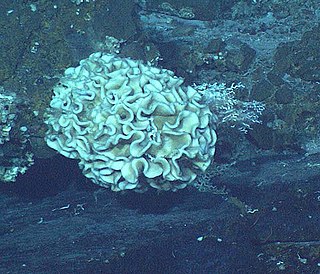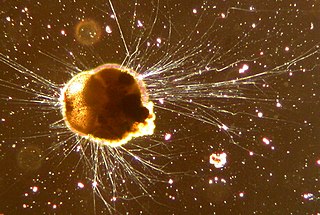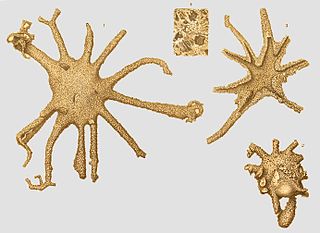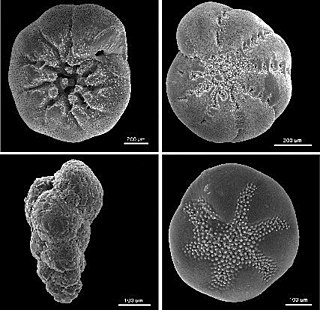Related Research Articles

Xenophyophorea is a clade of foraminiferans. Xenophyophores are multinucleate unicellular organisms found on the ocean floor throughout the world's oceans, at depths of 500 to 10,600 metres. They are a kind of foraminiferan that extract minerals from their surroundings and use them to form an exoskeleton known as a test.

Foraminifera are single-celled organisms, members of a phylum or class of Rhizarian protists characterized by streaming granular ectoplasm for catching food and other uses; and commonly an external shell of diverse forms and materials. Tests of chitin are believed to be the most primitive type. Most foraminifera are marine, the majority of which live on or within the seafloor sediment, while a smaller number float in the water column at various depths, which belong to the suborder Globigerinina. Fewer are known from freshwater or brackish conditions, and some very few (nonaquatic) soil species have been identified through molecular analysis of small subunit ribosomal DNA.
Ismailia is a genus of foraminifera with an agglutinated, planispirally coiled, semi-involute shell, known from the Egyptian Sinai, that lived during the early part of the Late Cretaceous (Cenomanian). Agglutinated shells are composed of selected foreign material cemented together.

The Allogromiida is an order of single-chambered, mostly organic-walled foraminiferans, including some that produce agglutinated tests (Lagynacea). Genetic studies indicate that some foraminiferans with agglutinated tests, previously included in the Textulariida or as their own order Astrorhizida, may also belong here. Allogromiids produce relatively simple tests, usually with a single chamber, similar to those of other protists such as Gromia. They are found as both marine and freshwater forms, and are the oldest forms known from the fossil record.

The Textulariida are an order of foraminifera that produce agglutinated shells or tests. An agglutinated test is one made of foreign particles glued together with an organic or calcareous cement to form an external shell on the outside of the organism. Commonly, the order had been made up of all species of Foraminifera with these types of shells, but genetic studies indicate these organisms do not form an evolutionary group, and several superfamilies in the order have been moved to the order Allogromiida. The remaining forms are sometimes divided into three orders: the Trochamminida and Lituolida, which have organic cement, and the Textulariida sensu stricto, which use a calcareous cement. All three orders or superfamilies are known as fossils from the Cambrian onwards.

In biology, a test is the hard shell of some spherical marine animals and protists, notably sea urchins and microorganisms such as testate foraminiferans, radiolarians, and testate amoebae. The term is also applied to the covering of scale insects. The related Latin term testa is used for the hard seed coat of plant seeds.

Carterinida is an order of multi-chambered foraminifera within the Globothalamea. Members of this order form hard tests out of thin calcite rods known as spicules, which are held together by a proteinaceous matrix. As of August 2023, the order contains a single family, Carterinidae.
The Spirillinida are an order of foraminifera in which the test, or shell, primitively consists of an enrolled open tube, coming after the proloculus, wound planospirally or conically, commonly composed of an optically single crystal of calcite. The aperture is a simple opening at the end of the tube. Advanced forms with more than one chamber may consist of a few crystals, or rarely, a mosaic of crystals of calcite.

The Foraminiferal Colouration Index (FCI) is a tool for assessing the thermal alteration of organic matter buried in sedimentary rock. It uses temperature-controlled colour changes in the organic cement of agglutinated foraminifera (microfossils) to estimate thermal alteration. The method is empirical and based on determination of colour by visual comparison of fossil specimens to the Geological Society of America Rock-Color Chart under a binocular microscope.

Rotalidia comprises a class of Foraminifera where Foraminifera is regarded as a phylum, that unites Foraminifera that have tests composed of secreted lamellar calcium carbonate, optically radial or granular calcite, or aragonite; separating them from those with porcelaneous, agglutinated, or microgranular, tests, or tests composed of organic compounds. Seven orders are included, the:
The Pseudogaudryinidae is a family of Late Cretaceous to recent benthic agglutinated Foraminifera included in the Textulariida. Tests are elongate with an early triserial stage, later reduced to biserial or uniserial. Walls are of agglutinated material and are canaliculate, that is have micro-tubular cavities. Apertures, an interiomarginal arch. The Pseudogaudryinidae differs from the Verneuilinidae in the canaliculate wall and from the Valvulinidae in having a simple aperture without a tooth.

Rotaliata is a class of Foraminifera characterized by tests that are exclusively multichambered, mostly planospiral or trochspiral, or derived from either. The aperture is commonly at the base of the apertural face, at least in early stages, but may be terminal, and single or complex. Test interior may be complex with secondary chambers and interconnecting canal system.

Astrorhizana are a subclass of foraminifera characterized by simple tests composed of agglutinated material that can be irregular, spheroidal, or tubular and straight, branching or enrolled. Tests are non septate and consist of a single chamber following the proloculus. These are the Ammodiscacea of the Textulariina in the Treatise Part C, that range from the Cambrian to Recent.
Miliamminana is a subclass of miliolates established by Mikhalevich, 1980 that combines two groups of foraminifers with agglutinated tests. They are the Rzehakinidae which previously were included in the Texulariina in the Treatise on Invertebrate Paleontology although milioline in form, and the milioline Schlumbergerinida which includes genera removed from the Miliolina. The rzehakinids are composed of finely agglutinated material, insoluble in acid, over an organic base. Schlumbergerinids are composed of acid soluble agglutinated material over a porcelenous base. The unifying character is the nature of their coiling in which there are two tubular chambers, or sections, per whorl arranged in various planes and the fact that they are in part all agglutinated.

Tubothalamea is a taxonomic class established for foraminiferans with tubular chambers. Includes the porcelaceous and agglutinated Miliolida and the monocrystalline and agglutinated Spirillinida. It is one of two classes of multichambered foraminifera based on SSU rDNA molecular studies with consideration of major morphological trands, the other being the Globothalamea.

Globothalamea comprises a class of multichambered foraminifera based in part on SSU rDNA evidence; the other is Tubothalamea.
The Ventrolaminidae are a family of benthic Foraminifera included in the Involutinida, now part of the subclass Spirillinana, class Spirillinata.
Stercomata are extracellular pellets of waste material produced by some groups of foraminiferans, including xenophyophoreans and komokiaceans, Gromia, and testate amoebae. The pellets are ovoid (egg-shaped), brownish in color, and on average measure from 10-20 µm in length. Stercomata are composed of small mineral grains and undigested waste products held together by strands of glycosaminoglycans.

"Monothalamea" is a grouping of foraminiferans, traditionally consisting of all foraminifera with single-chambered tests. Recent work has shown that the grouping is paraphyletic, and as such does not constitute a natural group; nonetheless, the name "monothalamea" continues to be used by foraminifera workers out of convenience.

Foraminiferal tests are the tests of Foraminifera.